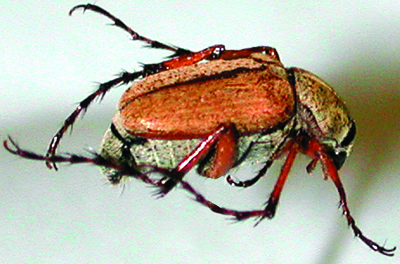Rose chafer
July 31, 2015
Macrodactylus subspinosis
Hosts
Rose, flowering cherry, crabapple, hydrangea, elm, elder, wisteria and several herbaceous perennials. The larvae overwinter as grubs in the soil, pupate in early spring and emerge in June. Look for adults as beautybush and European cranberrybush (Viburnum opulus) are blooming. Grubs feed on the roots of grasses, weeds, trees and shrubs, and are found in sandy soil. Rose chafers particularly favor feeding on rose flowers. Leaves skeletonized by rose chafers look very similar to those damaged by Japanese beetles.

Adult rose chafers are about 12 mm long with reddish-brown legs and buff to tan bodies. They lack the white tufts of hairs along the abdomen and metallic color of Japanese beetles.
Management
Floating row covers or netting may be used as barriers to protect plants, but may not be practical where plants are large or numerous. A pheromone trap specific for rose chafer is commercially available. This insect has few natural enemies and is poisonous to birds. Target the adult stage with a registered insecticide.
Print a PDF of this page: Rose chafer



 Print
Print Email
Email



